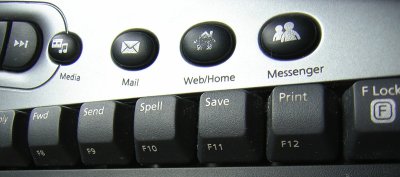Function keys and how to make the most use of them
Function Keys Are Useful
What Apps Use Function Key Shortcuts?
Function keys are used in many apps. Here's some almost universal keys:
- F11 full screen.
- F5 browser refresh.
- F2 rename, when in desktop folder, or in image viewer.
- F12 opens JavaScript console. (Chrome, Firefox, Edge) [see How to Run JavaScript]
- Photoshop. Help 【F1】, Cut 【F2】, Copy 【F3】, Paste 【F4】, Show/Hide Brush panel 【F5】, Show/Hide Color panel 【F6】, Show/Hide Layers panel 【F7】, Show/Hide Info panel 【F8】, Show/Hide Actions panel 【F9】, Revert 【F12】, Fill 【Shift + F5】, Feather Selection 【Shift + F6】, Inverse Selection 【Shift + F7】
If you are a programmer, many IDE or Linux terminal tools use all of the function keys.
- Linux
htop. [see Linux: Monitor Processes, “htop”] - Microsoft Visual Studio, 69 shortcuts involving function keys. [see Microsoft Visual Studio Function Key Shortcuts]
- Apple Xcode. (Step Into 【F7】, Step Over 【F6】, Step Out 【F8】 and more with modifiers.)
- Midnight Commander.
Following are tips on how you can customize the function keys for more productivity.
Switching Windows/Apps
One of the best use for function keys is switching apps. I've been using this since 1992, across {Mac, Windows, Linux}.
Normally, to switch app you have to do 【Alt+Tab】 or 【⌘ command+Tab】, or even using Windows Flip3D or Instant Viewer or Mac's “Mission Control” (aka Exposé). They involve multiple keys or mouse aim. The Tab is pressed by pinky — the weakest finger. But worst is that you have to take a second to eyeball among 10 windows to look for the one you want.
For most of us, there are 3 or 4 specific apps we use everyday, and have to constantly switch to it many times every hour. Examples: {browser, desktop, photoshop, terminal}.
It's good to have F5 F6 F7 F8 for switching to the apps you use the most often.
For how to set a key to switch app, see: How to Set Key to Switch to Browser.
What About App Launch Buttons?

On many keyboards, they have special buttons to launch apps. But these buttons have several problems:
- They are harder to press than Function keys.
- They are in hard-to-reach places.
- Their positions and size are not standardized. It requires looking to press the button.
What About Windows's QucikLaunch?
On Windows, if you have pinned apps in Taskbar of Windows 7 (or Quick Launch bar in Windows Vista), the keys are 【❖ Window+1】 【❖ Window+2】 etc. [see Windows Logo Key Keyboard Shortcuts]
These are not good shortcuts because:
- Two key combos is not as convenient as single key.
- The key 1 is in difficult positions pressed by pinky.
Undo, Cut, Copy, Paste
The traditional keys for {Undo, Cut, Copy, Paste} are Z X C V, while holding Ctrl or ⌘ command. That's 2 key presses. You can set F1 F2 F3 F4 to them.
Copy and Paste is by far the most used keys. Setting them to single key saves you a lot hand stress.
Here's how to:
- Linux how-to: Linux: Set F2 F3 F4 to Cut Copy Paste
- Mac how-to: Mac: Key Remapping, Keybinding Tools
- Windows how-to: Useful AutoHotkey Scripts
Switching Browser Tabs, Close Tab
Often, you have 10 tabs open in a browser. The hotkey to switch to previous/next tab varies depending on browser. For example, for Next Tab, there's:
- 【Ctrl+Tab】 (Internet Explorer, Firefox, Chrome, Safari)
- 【Ctrl+Page Down】 (Firefox, Chrome)
- 【⌘ command+Shift+→】 (Safari)
They all require multiple keys. Using a mouse is more cumbersome, because you have to take a second to aim at the right tab.
It would be very convenient to set F11 F12 for prev/next tab. Pressing one of these key can quickly fly you thru all your tabs.
By default, the key to close tab is 【Ctrl+w】.
Create a hotkey for closing the current tab. Depending on your keyboard, it can be Pause or F13.
(usually, in most browsers, you can press 【Ctrl+Shift+t】 to reopen. In Safari, it's undo 【Ctrl+z】)
- Linux how-to: Linux: Add Keyboard Shortcut to Switch App
- Mac how-to: Mac: Key Remapping, Keybinding Tools
- Microsoft Windows how-to: Useful AutoHotkey Scripts
Switching Virtual Desktop
On Mac, Linux, Windows 10, you have virtual screen called “workspace”. Typically, Linuxes lets you switch by 【Ctrl+Alt+→】 , or 【Ctrl+1】, 【Ctrl+2】. That's 2 or 3 combo-keys requiring both hands.
If you use Virtual Desktop heavily, then F9 F10 are perfect keys for it.
For Linux, just go to the control panel, then windows manager preference. See: Linux: Keyboard Software Guide
For Mac OS X, you can set in control panel too.
Function Key vs Key Combination, Which is Healthier, Which is Faster?
Function Key vs Key Chord, Which is Healthier, Which is Faster?
Using Numeric Keypad as Function Keys

There are often not enough function keys. But, you can:
- Use the numeric keypad as function keys.
- Buy a programmable keypad.
How to Program Number Keypad as Function Keys
How to Program Number Keypad as Function Keys
Buy Numerical Keypad
If your keyboard doesn't have number pad, you can buy them, cheap.
Programmable Keypads
Keyboard Keys Topic
- Keyboard Big Fat Enter Key
- Keyboard Home/End Keys Arrangement
- Tiny Space Bar on Japanese Keyboards
- Keyboard Page Key
- Print Screen, SysRq, ScrLk, Pause, Break Keys
- Control Key and Capslock Key Positions in Old Keyboards
- Keyboard Evolution: Zoom Button, Dedicated Keys
- Keyboards with Volume Wheel
- Keyboard Modifier Keys, Short Survey
- Why Function Keys Are Useful
- Keyboard Menu/App Key
- Backspace Key: Key Label's Influence on Key Purpose
- Alt Graph Key, Compose Key, Dead Key
